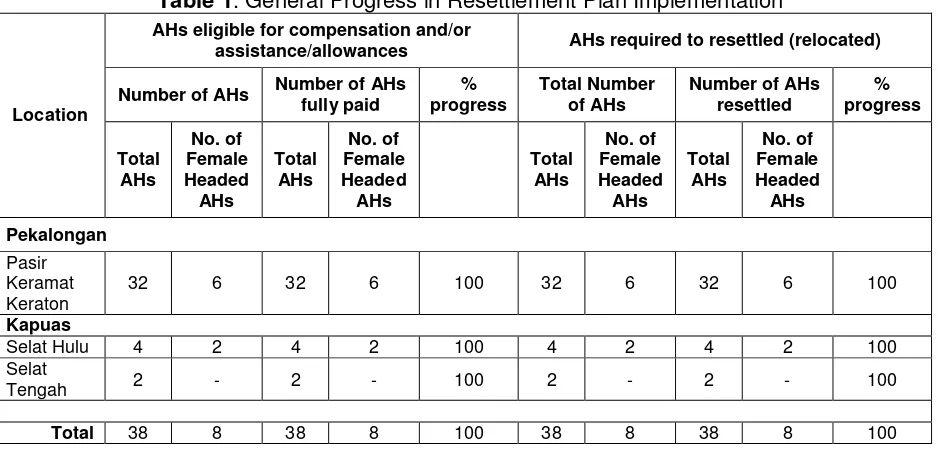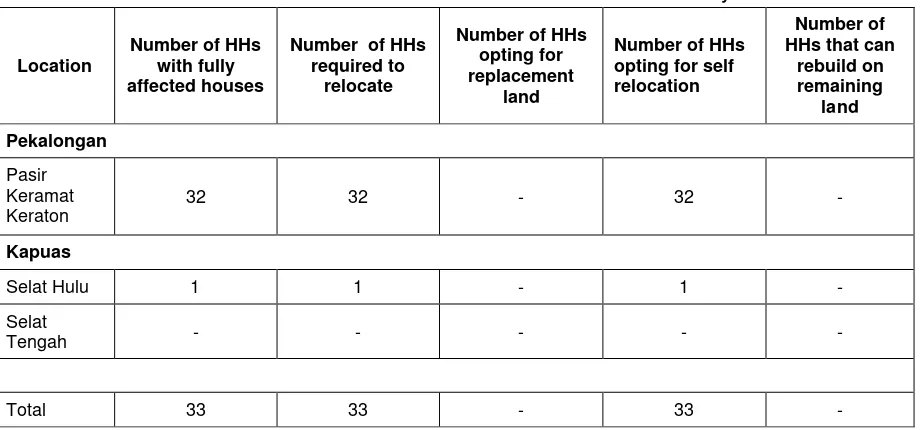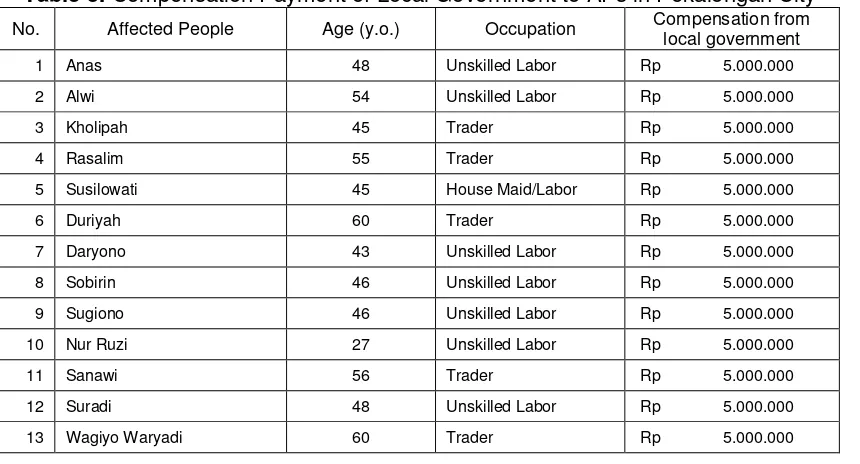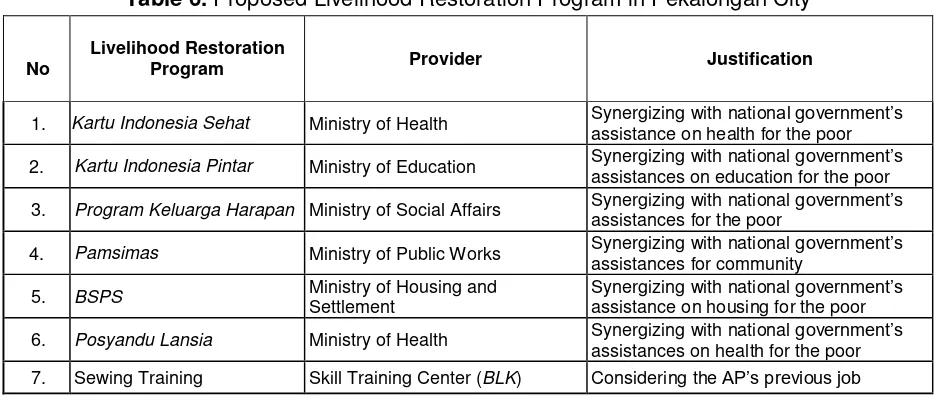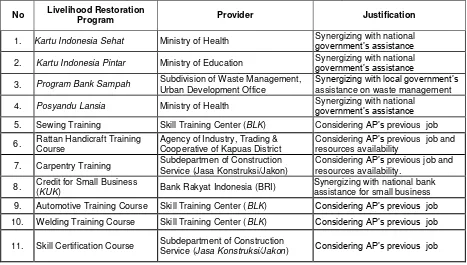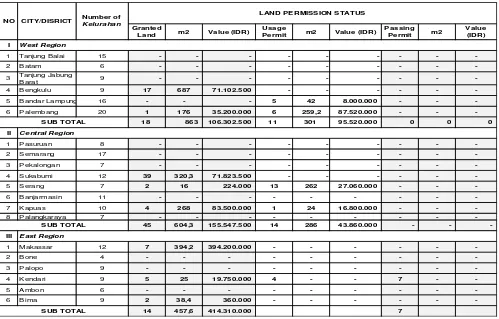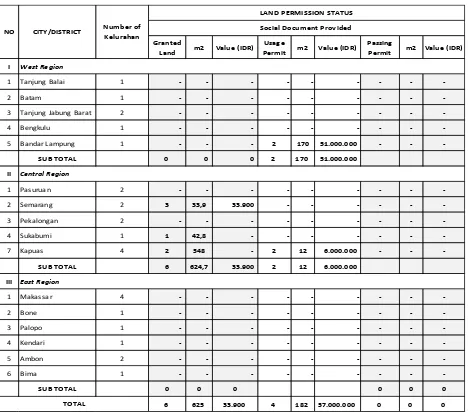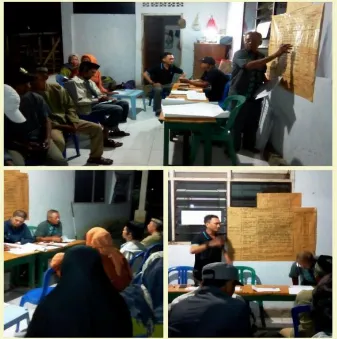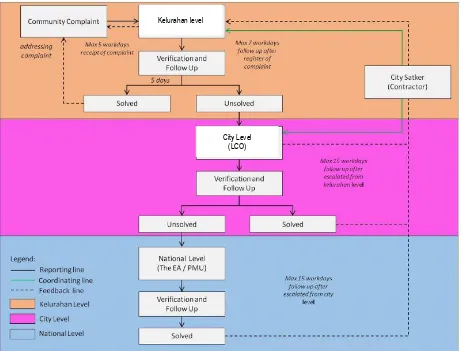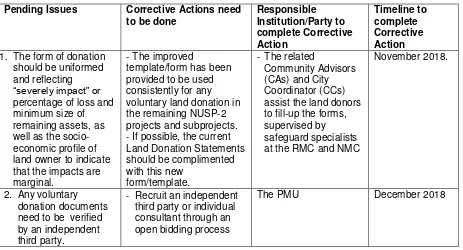Social Monitoring Report
#Semestral Report (January – June 2017) December 2018
Indonesia: Neighborhood Upgrading and Shelter
Project – Phase 2
CURRENCY EQUIVALENTS (as of 30 November 2018)
Currency unit – rupiah currency name in lowercase (Rp) Rp1.00 = $0.00007
$1.00 = Rp14,240
ADB – Asian Development Bank
APBD – Anggaran Pendapatan and Belanja Daerah (Regional Budget Income and Expenditure)
DGHS – Directorate of Human Settlements
NOTE
(i) The fiscal year (FY) of the Government of Indonesia and its agencies ends on 31 December. “FY” before a calendar year denotes the year in which the fiscal year ends, e.g., FY2011 ends on 31 December 2011.
(ii) In this report, "$" refers to US dollars.
This social monitoring report is a document of the borrower. The views expressed herein do not necessarily represent those of ADB's Board of Directors, Management, or staff, and may be preliminary in nature.
1
CHAPTER I. PROJECT BACKGROUND AND DESCRIPTION ... 4
CHAPTER II. PROJECT IMPLEMENTATION PROGRESS ... 6
CHAPTER III. RESETTLEMENT ... 7
CHAPTER IV. COMPENSATION AND INCOME RESTORATION PROGRAM ... 9
CHAPTER V. LAND DONATION ... 12
CHAPTER VI. DISCLOSURE, CONSULTATION AND PARTICIPATION ... 16
6.1. Disclosure ... 16
6.2. Public Consultation/Information Dissemination Meetings ... 16
CHAPTER VII. GRIEVANCE REDRESS MECHANISM (GRM) ... 18
CHAPTER VIII. INSTITUTIONAL ARRANGEMENT AND CAPACITY BUILDING ... 20
CHAPTER IX. CONCLUSION AND CORRRECTIVE ACTIONS ... 21
9.1. Conclusion ... 21
9.2. Corrective Actions ... 21
2
LIST OF TABLES
Table 1. General Progress in Resettlement Plan Implementation ... 7
Table 2. Disbursement and Resource of Funds ... 8
Table 3. Confirmed Resettlement Preferences for households with fully Affected Houses ... 8
Table 4. Compensation Payment of Local Government to APs in Kapuas District ... 9
Table 5. Compensation Payment of Local Government to APs in Pekalongan City ... 9
Table 6. Proposed Livelihood Restoration Program in Pekalongan City ... 10
Table 7. Proposed Livelihood Restoration Program in Kapuas District ... 11
Table 8. General Progress on Land Handover for Community Contracts ... 14
Table 9. General Progress on Land Handover for Complex Civil Work Packages... 15
Table 10. Pending Issues and the Corrective Actions ... 21
LIST OF FIGURE
Figure 1. Photo Documentation of Kelurahan Meeting (Muskel) III at Pasir Kramat Keraton, Pekalongan. ... 17Figure 2. Photo Documentation of the Meeting of Analysis of Infrastructure Needs in Kelurahan Paccerakang, Makassar City. ... 17
Figure 3. Work Flow of Grievance Redress Mechanism ... 19
LIST OF APPENDICES
Appendix 1. Statement of Claim for Land Possession of NSD Kendari ... 23Appendix 2. Certificate of Land Title of NSD Palopo ... 25
Appendix 3. Letter Ref. HL.02.02-CK/297 concerning no IR in FY 2017 ... 40
Appendix 4. Statement of Land Donation in Makassar ... 41
Appendix 5. Statement of Land Donation in Kendari ... 43
Appendix 6. Statement of Land Donation in Bengkulu ... 45
Appendix 7. Statement of Land Donation Serang ... 49
Appendix 8. Notes and Information on Community Land Affected by NUSP-2 activities ... 52
Appendix 9. Voluntary Land Donation Statement ... 54
Appendix 10. Minutes of Kelurahan Meeting III in Pasir Kraton Kramat, Pekalongan, Sabtu 23 March 2017 ... 56
Appendix 11. List of Attendees in Kelurahan Meeting III in Pasir Kramat Kraton, Pekalongan . 59 Appendix 12. Minutes of meeting of Public Consultation on Analysis of Infrastructure Needs in Kelurahan Paccerakang, Makassar ... 61
3
ABBREVIATION
ADB Asian Development Bank
AH Affected Household
AP Affected People
APBD Anggaran Pembangunan dan Belanja Daerah (Regional Budget Planning)
BPJS Kesehatan Badan Penyelenggara Jaminan Sosial Kesehatan (Social Security for Health)
BPN Badan Pertanahan Nasional (National Land Agency)
BSPS BantuanStimulanPerumahan Swadaya (Self-help Housing Assistance)
CA Community Adviser
CC City Coordinator
CIO Community Implementing Organization
DED Detailed Engineered Design
DDR Due Diligence Report
DGHS Directorate General of Human Settlement
EA Executing Agency
EMP Environmental Management Plan
FGD Focus Group Discussion
FY Fiscal Year
GAP Gender Action Plan
GRM Grievance Redress Mechanism
Ha Hectare
HH Household
IEE Initial Environmental Examination
IP Indigenous People
IPAL Instalasi Pengolahan Air Limbah (Wastewater treatment plant)
LARP Land Acquisition and Resettlement Plan
LCO Local Coordinating Office
LG Local Government
MDG Millennium Development Goals
NMC National Management Consultant
NSD New Site Development
NPW Nilai Perkiraan Wajar (Reasonable Reimbursement Value)
NUAP Neighborhood Upgrading Action Plan
NUSP-2 Neighborhood Upgrading and Shelter Program Phase 2
PDAM Perusahaan Daerah Air Minum (local government owned clean water
provider)
PIP Pengembangan Infrastructure Pemukiman (Settlement Infrastructure Development)
PIU Project Implementing Unit (Satker or Satuan Kerja)
PMU Project Management Unit
PPP Public Private Partnership
PWH Public Works and Housing
RAB Rencana Anggaran Belanja (Project Budget)
RMC Regional Management Consultant
RP Resettlement Plan
RTRW Rencana Tata Ruang dan Wilayah (Spatial Plan)
RT/RW Rukun Tetangga/Rukun Warga (Subdivision Institution under RW/
Subdivision Institution under Kelurahan)
Satker PKPBM Satuan Kerja Peningkatan Kualitas Permukiman Berbasis Masyarakat
(National PIU of Settlement Quality Improvement)
SIAP Slum Improvement Action Plan
4
CHAPTER I. PROJECT BACKGROUND AND DESCRIPTION
1. Approved on 31 March 2014, NUSP2 is aimed to upgrade basic public infrastructure in slums, and contribute to meeting Millennium Development Goals (MDGs) targets for achieving significant improvement in the lives of slum dwellers (MDG target 7D) and halving the proportion of urban households without sustainable access to safe drinking water and basic sanitation (MDG target 7C). The Project contributes to the implementation of the Cities without Slums Program launched by the Government to address issues of the rapid urbanization. The project covers 20 cities and improves basic infrastructure and living conditions in selected slums.
2. NUSP Phase 2 assists 20 cities to develop and implement inclusive pro-poor city development plans. The project improves living conditions in slum areas through (i) providing resources to local governments and communities for upgrading basic infrastructure in slum areas, (ii) strengthening planning and management capacities of local administrations for inclusive pro-poor urban planning, (iii) establishing sustainable mechanisms to engage communities in urban development planning processes, and (iv) launching public private partnerships (PPPs) to establish affordable housing areas for poor families.
3. As stipulated in the Project Data Sheet, the NUSP-2 has a Safeguard Category B for Involuntary Resettlement and Category C for Indigenous Peoples. The Category B means the project will not include physical displacement and loss of more than 10 percent of productive assets (income generating) of 200 or more persons due to involuntary land acquisition. And the Category C for Indigenous Peoples means that the Project is not expected to have any negative impacts on indigenous people, as there are no indigenous people reported in location nearby the project locations.
4. Since the project will adopt CDD approach, the specific intervention will be identified by the community members only during project implementation, thus potential issues related to land acquisition can be identified only at later stage. In the context of specific neighborhood upgrading activities, i.e. construction of public sanitation facilities, small land portions might be acquired from community members or donated voluntarily. Land required for new settlement for poor families will be provided by participating districts/cities government and resettlement issues are not expected or to be minor.
5. The expected impact of the NUSP-2 is improved living conditions in urban areas. The outcome is improved infrastructure and access to service delivery in slum neighborhoods in 20 project cities. As for the outputs, the NUSP-2 has three outputs: (i) Institutional capacities for managing pro-poor urban development strengthened; (ii) infrastructure in slum neighborhoods upgraded; and (iii) new settlements for poor families established.
6. In efforts to improve infrastructure in slum neighborhoods effectively, the infrastructure activities under NUSP-2 are grouped into three categories of work packages:
1). Community contracts (skala lingkungan); 2). Complex civil works (skala kawasan); 3). New Site Development.
5
8. The New Site Development (NSD) Construction Activity. The NSD plans to construct the public facilities and infrastructures for the newly built neighborhood, such as paving roads, drainage system, clean water supply, solid waste management system and landscape for open green space. There are 4 (four) cities/districts participating in the NSD projects, namely: Kendari City, Palopo City, Bima City and Kapuas District. The NSD activity is also implemented by contracted firm selected through bidding process, but has many types of infrastructure works in a new land including house construction which implemented by the DGHP.
6
CHAPTER II. PROJECT IMPLEMENTATION PROGRESS
10. Community Contract Activity. During the first half of 2017, the NUSP-2 Project was conducted in 204 kelurahans within 20 cities. Community Implementing Organizations (CIO or
BKM, Badan Keswadayaan Masyarakat) assisted by Community Advisors (CA) have formulated 204 Community Action Plans (CAPs or RKM, Rencana Kerja Masyarakat) for first cycle (Siklus I) in 204 kelurahans. The planned community contracts may need small land portion through land donation, which are subject to basic principle of land donation in Resettlement Framework Paragraph 29, 30 and 31.
11. Complex Civil Works Construction Activity. In 16 cities/districts the planning documents of 24 work packages have been formulated by consultants, which recruited by local government’s Budget/APBD of fiscal year 2017. The planned work packages may need small land portion from community, which will be provided through land donation, hence neither land acquisition report and resettlement plan will be required.
12. However, as the project implementation in complex civil works in Kapuas District and Pekalongan City in 2016 have affected 149 peoples or 38 households and caused resettlement, a Resettlement Due Diligence Report is being prepared for each location. Such report is aimed to provide information that the process of resettlement do not excess the major impact, and the affected people were provided with proper entitlement, as well as adequate recovery programs. The monitoring of these recovery programs will be further elaborated in Chapter IV Compensation and Income Restoration Program.
13. New Site Development. The government of Kendari City has secured approval for land utilization in Purirano for the NSD site from the local parliament at 2015. The land status is under possession of the government of Kendari City as shown in the Statement of Claim for Land Possession in Appendix 1.
14. In Palopo City, the local government has acquired the total area of 2.0 hectares land in Sampoddo in December 2016. The land was acquired from two households through negotiated land acquisition procedure set forth in the Law No. 2/2012 on Land Acquisition for Development of Public Interest and its implementing regulations. However, the land was unoccupied and unproductive. Therefore, this land acquisition did not affect the productive income. The two Affected Households (AHs) are considered significantly affected as the lost land is more than 10% of total assets owned, hence they are entitled for income recovery and livelihood program. The Local Government of Palopo City is preparing to deliver the livelihood recovery program for the affected households living in Palopo and the family members (son and daughters). The monitoring of these recovery programs will be reported in the next Semi Annual Monitoring Report. The land title certificate for the government of Palopo City was issued in February 2017 as shown in Appendix 2.
15. For the NSD in Bima, the government of Bima City has requested 3.7 Hectares land asset in Jatiwangi from the government of Bima District in May 2017. The government of Bima District is now awaiting for approval of their local parliament (DPRD) to transfer the asset to the government of Bima City. This land was formerly property of the Government of NTB province but transferred to the government of Bima District. The Due Diligence Report for this NSD will be prepared around first quarter of 2018.
7
CHAPTER III. RESETTLEMENT
17. During this reporting period (January-June 2017), no involuntary resettlement (IR) or loss more than 10% of productive assets were reported. This is emphasized in the letter from the Director of Settlement Development of MPWH, ibu Ir. Rina Farida, dated 12 June 2017 to the Country Director ADB-IRM, informing that the civil works packages in FY 2017 will not require land acquisition or resettlement process (Appendix 3. Letter Ref. HL.02.02-CK/297 concerning no IR in FY 2017).
18. The land acquisition requirement on small land for project construction activities was fulfilled voluntarily, where all the affected land owners did not demand any compensation in return. The NMC has encouraged the RMC to carefully identify and inventory all land donations and completed with supporting documents. Land donation will be discussed separately in Chapter V.
19. The NUSP-2 activities implemented during this period of reporting did not bring impacts on resettlement, except on Kapuas District and Pekalongan City. Therefore, this chapter will discuss more on the resettlement in Kapuas District and Pekalongan City occured in FY 2016, which has not yet been reported in the previous Semi Annual Social Monitoring Report.
20. As the NUSP-2 implementation of complex civil works in Kapuas District and Pekalongan City had caused resettlements in 2016, this year the local governments have provided payment for affected assets compensation, allowances, loss of incomes, etc. To the affected persons. The implementation progress of compensation payment and resettlement is shown in Table 1 below, followed by Table 2 on the progress of disbursement, source of funding, and allocation. In addition, the local government also provided other types of compensation for income rehabilitation programs. Description about compensation and recovery program is presented in the next chapter.
Table 1. General Progress in Resettlement Plan Implementation
Location
AHs eligible for compensation and/or
assistance/allowances AHs required to resettled (relocated)
Number of AHs Number of AHs
8 Table 2. Disbursement and Resource of Funds
Location
22. In Pekalongan City, 32 (thirty two) houses located on slum area were fully affected by the drainage construction under complex civil work package. All affected households (of 124 people) were landless and proposed to move to anticipated rental apartment, but they preferred self-relocation. In Kapuas District, the construction of bridges fully affected a house and partially affected five other houses which totally affected 25 people (6 HHs). The only fully affected household was also landless and relocated to nearby location in option of self-relocation (See Table 3).
Table 3. Confirmed Resettlement Preferences for households with fully Affected Houses
9
CHAPTER IV. COMPENSATION AND INCOME RESTORATION PROGRAM
23. As of June 2017, within this reporting period, no land acquisition and resettlement issues emerged during construction activities, except in Kapuas District and Pekalongan City. Having said in previous Chapter that there are resettlement issues in Kapuas District and Pekalongan City, this chapter will further describe the compensation and income restoration program for the affected peoples (APs) of those two locations. No resettlement program needed for other locations. However, for any activities in the future which would involve with land acquisition and cause any resettlement & rehabilitation, physical or economic displacement, the Resettlement Plan (RP) will be prepared accordingly and subsequently with necessary monitoring of RP implementation. Thus, the status of compensation payment to affected peoples (APs) for their asset loss and mitigations of different other social safeguard issues, if any, will be included in the next semi annual report.
4.1. Compensation
24. As the consequence of resettlement caused in FY 2016, the local governments of Kapuas District and of Pekalongan City have accomplished payment of compensation to the affected people. Table of the affected people with their compensation payment is provided in
Table 4 and Table 5 below. In order to ensure the affected people obtain appropriate entitlements to physical and non-physical losses, a reasonable reimbursement value (RRV) was calculated based on Law no. 2/2012. The result of RRV calculation was compared with the amount of paid compensation by the local government. This comparison was used to determine a gap between both components. When the gap found positive it reflects inadequate paid compensation. Therefore a series of restoration programs is being identified to be proposed to fill the gap.
Table 4.Compensation Payment of Local Government to APs in Kapuas District
No. Affected People Age (y.o.) Occupation Compensation from local government
Table 5. Compensation Payment of Local Government to APs in Pekalongan City
No. Affected People Age (y.o.) Occupation Compensation from
10
No. Affected People Age (y.o.) Occupation Compensation from
local government
25. The RRV calculation has been done to the loss of the affected people both in Kapuas District and Pekalongan City. However, it is concluded that the paid compensation by the local governments were not sufficient. Therefore, the local governments of Kapuas and Pekalongan have committed to also provide restoration programs for the affected people.
4.2. Income Restoration Program
26. Both local governments are identifying the suitable recovery programs to be offered to the affected people. The process of program identification is carried out by considering educational background, previous work experience and preference of the affected people. The livelihood recovery or restoration programs proposed by the local governments of Pekalongan and Kapuas are presented in the following tables (Table 6 and Table 7).
Table 6. Proposed Livelihood Restoration Program in Pekalongan City
No
Livelihood Restoration
Program Provider Justification
1. Kartu Indonesia Sehat Ministry of Health Synergizing with national government’s assistance on health for the poor
2. Kartu Indonesia Pintar Ministry of Education Synergizing with national assistances on education for the poor government’s
3. Program Keluarga Harapan Ministry of Social Affairs Synergizing with national government’s assistances for the poor
4. Pamsimas Ministry of Public Works Synergizing with national assistances for community government’s
5. BSPS Ministry of Housing and
Settlement
Synergizing with national government’s assistance on housing for the poor
11
No
Livelihood Restoration
Program Provider Justification
8. Carpentry Training Subdepartmen of Construction
Service (Jasa Konstruksi/Jakon) Considering previous AP’s job 9. Automotive Training Course Skill Training Center (BLK) Considering AP’s previous job
10. Agriculture & Fishery
Processing Skill Training Center (BLK) Considering previous AP’s job
Table 7. Proposed Livelihood Restoration Program in Kapuas District
No Livelihood Restoration Program Provider Justification
1. Kartu Indonesia Sehat Ministry of Health Synergizing with national government’s assistance
2. Kartu Indonesia Pintar Ministry of Education Synergizing with national government’s assistance
3. Program Bank Sampah Subdivision of Waste Management,
Urban Development Office
Synergizing with local government’s
assistance on waste management
4. Posyandu Lansia Ministry of Health Synergizing with national government’s assistance
5. Sewing Training Skill Training Center (BLK) Considering AP’s previous job
6. Rattan Handicraft Training Course Agency of Industry, Trading & Cooperative of Kapuas District Considering resources availability AP’s previous job and
7. Carpentry Training Subdepartmen of Construction Service (Jasa Konstruksi/Jakon)
Considering AP’s previous job and resources availability.
8. Credit for Small Business (KUK) Bank Rakyat Indonesia (BRI) Synergizing with national bank assistance for small business
9. Automotive Training Course Skill Training Center (BLK) Considering AP’s previous job
10. Welding Training Course Skill Training Center (BLK) Considering AP’s previous job
12
CHAPTER V. LAND DONATION
27. The relevant basic principles set forth in the Resettlement Framework document (paragraph 29, point a, d, g and i) to be applied for the projects are as follows:
(i) Acquisition of land and other assets shall be avoided and minimized as much as possible by exploring project and design alternatives and appropriate social, economic, operational, and engineering solutions that have the least impact on populations in the project area.
(ii) APs shall be fully consulted and informed on the project, their entitlement and resettlement options. As well as the assistance measures. Ensure the APs participation in planning, implementation, and monitoring and evaluation of resettlements programs. Particular attention will be provided to the vulnerable groups and ensure their participation in consultations.
(iii) There shall be an effective grievance redress mechanism to receive and facilitate
resolution of the affected persons’ concern during the preparation and implementation of LARPs.
(iv) Appropriate monitoring shall be carried out to assess land acquisition objectives and their impacts on the standard of living of the APs. The M& E, mechanisms shall be identified and set in place as part of the land acquisition management system. Monitoring reports should be disclosed.
28. As the project of the NUSP-2 are specific neighborhood upgrading activities, only small land portions acquired from community members or donated voluntarily. Land required for the new settlement for poor families in NSD sites would be provided by participating district or city governments. Hence, the resettlement issues are not expected to occur or just minor.
29. Concerning the basic principles point (ii), prior to the commencement of construction works in NUSP-2 subprojects, there are socialization or information dissemination meeting for the potential affected people to be fully informed and consulted about the project, their entitlement and resettlement option. More on this information disclosure will be discussed in Chapter VI. Disclosure, consultation and Participation.
30. As for the basic principles point (iii), the NUSP-2 has developed grievance redress
mechanism to receive and facilitate the AP’s concerns, and will be further described in Chapter VII. The appropriate monitoring will be carried out and the monitoring report would be disclosed.
31. When the project construction activities require a small land acquisition, the project communities or individuals may decide to make voluntary contribution of the affected land and non-land assets. It occurs if the affected land owners did not demand any compensation in return. The land donation shall not cause significant loss to the owner and the owner must be a direct beneficiary of the project. According to the resettlement framework, this shall be acceptable only if the following requirements are in place:
(i) Full consultations with the land owners and any non-titled displaced persons on site selection;
(ii) Ensuring that voluntary donations do not severely affect the living standards of the APs, and are linked directly to benefits for the APs, with community sanctioned measures to replace any losses that are agreed to through verbal and written record by the APs;
13
(iv) Any voluntary “donation” will be confirmed through verbal and written record and verified by an independent third party such as a designated non-government organization or legal authority;
(v) Having adequate grievance redress mechanism in place; and
(vi) Safeguards must be built into the community decision making process and included in the project implementation guideline to be followed by project consultants and facilitators and shared with the project community members.
32. As the NUSP-2 adopts the CDD approach, the specific intervention is identified by the community members themselves during project implementation. So the land owners and any non-titled displaced person are fully consulted through series of kelurahan meeting (Muskel). However, as the process of land provision that may need land donation has been done in an open and transparent manner through the Muskel II and III, the communities are not aware or feel necessary to confirm this voluntary donation through verbal or written record by an independent third party as required in point (iv) of paragraph 28 above (paragraph 30 of RF document). There is no documentation of such confirmation as well due to poor documentation at the community level. The project is considering recruiting an independent individual as the third party to verify verbal or written records of voluntary land donation process. All the process of these land donations have still been partially complied with the RF procedure as set forth in paragraph 29-31 of RF document, and will be improved in the FY 2018 land donation procedures.
33. Land donation by beneficiary households is acceptable where:
(i) the impacts are marginal (based on percentage of loss and minimum size of remaining assets);
(ii) impacts do not results in displacement of households or cause loss of household’s incomes and livelihood;
(iii) the households making land donations are direct beneficiaries of the project; (iv) donated land is free from any dispute on ownership or any other issues;
(v) consultations with the affected households are conducted in a free and transparent manner;
(vi) land transactions are supported by transfer of titles; and
(vii) proper documentation of consultation meetings, grievances, and action taken to address such grievances is maintained.
34. In NUSP-2 Project, the land donation is based on Community Self-survey (Survey Kampung Sendiri) from which the community identify the need for infrastructure mentioned in the Neighborhood Upgrading Action Plan (NUAP) document. The need for piece of land for infrastructure then being identified, discussed and assessed during the Kelurahan Meeting II (Musyawarah Kelurahan/Muskel II) through meaningful consultation. Further, in the Muskel III, the community finalizes and agrees upon the Community Action Plan (CAP), including the land donation and proceed with signing the statement of land donation later on. In fact, these land donations are voluntarily and are some forms of community contribution to the project without any coercion. Allowing for that land donation is less than 10 percent, the impact is also marginal.
14
dispersed in Bengkulu, Bandar Lampung, Palembang, Sukabumi, Serang, Kapuas, Makassar, Kendari and Bima. These construction activities caused no involuntary resettlement or losing of their productive assets. The description of land donation process recorded in minutes, statement of land donation, list of attendance and photo documentation. As some examples,
Appendix 4, 5, 6, and 7 show the statement of land donation in neighborhoods of Kendari, Bengkulu and Serang.
36. However, the examples show some variety of the donation form which reflecting the interpretation of the community from different location on the basic land donation form/template provided by the project. This variety needs to be uniformed and reflects severely impacts it may cause, as well as all required principles/procedures as set forth in the RF document. Therefore, a new template or form for land donation document has been prepared and provided in the Appendix 8 (Notes and Information on Community Land Affected by NUSP-2 Activities). This form is complimented with the Land Donation Statement (Appendix 9), and includes some profile of the land owner to indicate that the impacts are marginal (based on percentage of loss and minimum size of remaining assets), and that impacts do not results in
displacement of households or cause loss of household’s incomes and livelihood. These two forms would be used unanimously in all land donation document in the remaining NUSP-2 project and subproject. The recapitulation of land handover for community contract in 2017 is provided in Table 8 below.
Table 8. General Progress on Land Handover for Community Contracts
15
process of these land donations have been complied with the RF procedure as set forth in paragraph 29-31 of RF document. The description of land donation process recorded in minutes, statement of land donation, list of attendance and photo documentation. Details are provided in Table 9 below.
Table 9. General Progress on Land Handover for Complex Civil Work Packages
16
CHAPTER VI. DISCLOSURE, CONSULTATION AND PARTICIPATION
6.1. Disclosure
38. The Due Diligence Report and regular monitoring report are subject to public disclosure. Therefore, these documents will be made available to public including the affected people and related stakeholders. This Semi Annual Social Monitoring report will be uploaded on the ADB
and PWH Ministry websites, as well as on the local Satker’s website. Furthermore, the
information about the due diligence report will be summarized in the form of leaflet for dissemination to the affected households and peoples. These information leaflets are being prepared for public dissemination. CONSULTATION AND PARTICIPATION
6.2. Public Consultation/Information Dissemination Meetings
39. Public consultation is done to provide an opportunity for affected people including landowners who sold their land assets as well as peoples who own land next to the planned construction location. Specifically, the consultation is conducted to establish agreements about land boundaries, land prices, and administrative processes of handover ownership. The statement letter on the compensation payment release of the land right is signed by the two parties (seller and buyer) and the explanation of the release of land rights is also carried out and signed and by local authority (sub district head) and witnessed by at least two persons.
40. Similar condition applies to land donation, full consultations with the land owners and any non-titled displaced persons on site selection is required to make acceptable land donation.The statement letter on release of land right is signed and acknowledge by local authority and witnessed by at least two person.
41. The City Satker (PIUs) of Kapuas District and Pekalongan have conducted meaningful consultations with APs, their communities and other civil society members for every project and subproject identified as having involuntary resettlement impacts. The City Satker paid particular attention to the need of disadvantaged or vulnerable groups, especially those below the poverty line, the landless, the elderly, female headed households, women and children, and those without legal title to land. Unfortunately, the consultation meeting in Kapuas District was poorly documented at this stage. Meanwhile, the consultation meeting in Kelurahan Pasir Keramat Kraton, Pekalongan City, the meeting (Muskel III) was held on 23 March 2017, attended by 16 men and 8 women (Figure 1). The minutes of this meeting and the list of attendees is provided in Appendix 7 and 8.
17 Figure 1. Photo Documentation of Kelurahan Meeting (Muskel) III at Pasir Kramat Keraton,
Pekalongan.
18
CHAPTER VII. GRIEVANCE REDRESS MECHANISM (GRM)
43. Grievance redress mechanism is used as an instrument to handle any complaints and/or queries which emerge during land donation process and during construction process of the NSD project. Any affected people/party will have the right to file complaints. It is anticipated that all grievances related to benefits and other assistance will be expected to be resolved at the subproject as the project upholds CDD (community-driven development) as the overarching approach.
44. The procedure for filing complaints and/or grievance during construction is established as follows:
(i) The complaint will be filed to the Badan Keswadayaan Masyarakat (BKM) or Community Implementing Organization (CIO) members and local government at the neighborhood level for an immediate solution when possible; and
(ii) If the problem cannot be solved, the BKM members and local government staff will facilitate the APs (affected peoples) to submit their complaints to the Projects’s grievance redress committee (GRC) at the district level, and to the national level if needed. Community advisor then will record the complaint and report it to the LCOs. The project will dedicate a staff at city/district and national levels to be in charge of handling and following up on AP’s complaints.
45. The handling procedure by GRC on complaints and/or grievance is as follows:
(i) The members of the GRC should involve the representatives of vulnerable affected people (i.e. affected women, poor and minority groups) and other affected people along with relevant government officials who have functional and legal authority. The committee will then review grievances involving all land acquisition benefits or issues, except for disputes related to ownership.
(ii) Grievances will be redressed within 2 to 4 weeks from the date of filing the complaints at the district level and within 8 weeks at the national levels. If no consensus can be reached, the dispute resolution will refer to the grievance mechanisms based on Law No. 2/2012 on Land Acquisition for the Development of Public Interest and Presidential Regulation No. 71/2012 on the Implementation of Land Acquisition for the Development of Public Interest.
46. The project is preparing to establish a grievance redress mechanism, which basically consists of three levels, i.e. at the kelurahan (neighborhood), the city/district and the national level. This leveling system is expected to timely address any complaints during project implementation. Affected people will have the right to file complaints and/or queries related to adverse impacts due to project activities. Community complaints that will emerge later on, will be handled with grievance redress mechanism in accordance with the complaint handling guidelines which had been prepared by the DGHS in this reporting period.
47. At the neighborhood (kelurahan) level, the kelurahan office will register complaints and subsequently resolve the complaints; the Kelurahan office will coordinate and provide feedback to the contractor and City Satker in this matter. If the grievance cannot be resolved at the
kelurahan office, the complaint will be escalated to the city level. At the city level, the complaints will be handled by the Local Coordinating Office (LCO) residing at the Bappeda
19
resolved at the city level, it will be escalated to the PMU which representing the DGHS, at the national government level.
Figure 3.Work Flow of Grievance Redress Mechanism
48. Once the Grievance Redress Mechanism is established and disseminated to all level stakeholders and community, it shall be effectively implemented to receive complaints and facilitate resolution of the affected people during the process of Land Acquisition and Resettlement Plans (LARP) preparation and implementation. Regular report on the progress of GRM implementation will be presented in the next semi annual report.
20
CHAPTER VIII. INSTITUTIONAL ARRANGEMENT AND CAPACITY BUILDING
49. To support the implementation of NUSP-2, there is a project management organization that includes government, community and consultants, from the central, district/city level, to the
Kelurahan and the community.
50. The Directorate General of Human Settlements is the Executing Agency (EA) of NUSP-2, at the central level the EA assisted by the Project Management Unit (PMU) and the Satker PKPBM as the Project Implementation Unit (PIU). The national PIU is assisted by a national management consultant (NMC). At the city level, there is a Local Coordinating Office (LCO) of Kapuas District and City Satker of Kapuas District as a Project Implementation Unit at the city level. At the city level, a Regional Management Consultant (RMC) is assigned to assist the city satker. The Directorate General of Human Settlements is responsible for the management of LARP compiled by the LCO and Satker with the assistance of Technical Assistant (TA) on Safeguard at the RMC level. Consultants (RMC, CC, and CA) along with Satker at the city level will continue to monitor and update LARP.
21
CHAPTER IX. CONCLUSION AND CORRRECTIVE ACTIONS
9.1. Conclusion
52. Based on the monitoring, review and some analyses of social impacts on the local community livelihoods and assets, within this reporting period the NUSP-2 projects and subprojects did not include physical displacement and loss more than 10 percent of productive assets and income generation. No land acquisition and involuntary resettlement issues emerged during construction activities, except in Kapuas District and Pekalongan City, for which the compensation and income restoration program are being provided for the affected Resettlement Framework are considered as partly compliance and need the corrective actions to comply with those requirements and principles, as shown in Table 10 below. These corrective or remedial actions will be monitored and also reported in the next Semi Annual Monitoring Report.
Table 10. Pending Issues and the Corrective Actions
Pending Issues Corrective Actions need
52 Appendix 8. Notes and Information on Community Land Affected by NUSP-2 activities
LEMBAR CATATAN LAHAN MASYARAKAT YANG TERKENA KEGIATAN NUSP-2
RMC WILAYAH :
Luas lahan yang digunakan untuk lokasi kegiatan NUSP-2 :
Luas lahan milik penduduk yang tekena dampak kegiatan NUSP-2 :
Lampirkan fotocopy bukti kepemilikan lahan kalau ada.
Atas nama :
Pekerjaan :
Pendapatan perbulan : Jumlah Tanggungan :
Umur : Jenis Kelamin : L / P
Kategori Kepala Keluarga :
Perempuan MBR1 Penyandang Disabilitas
Lansia Tidak termasuk
Foto lokasi yang dihibahkan : Softcopy Hardcopy
Lahan milik penduduk yang terkena dampak kegiatan NUSP-2 tersebut berstatus :
Donasi/dihibahkan Dijual Pinjam pakai
Bangunan yang terkena dampak kegiatan NUSP-2 :
Ada Tidak Ada
Bila ada, jelaskan :
...
...
...
Apakah ada tempat usaha penduduk setempat yang terkena dampak kegiatan NUSP-2
Ada Tidak Ada
Bila ada, jelaskan :
...
...
1 Masyarakat Berpenghasilan Rendah; mengacu pada Tabel BPS mengenai Garis Kemiskinan Menurut
53 Apakah ada tanaman atau pepohonan yang terkena dampak kegiatan NUSP-2
Ada Tidak Ada
Jika ada sebutkan, jenis... jumlah... dan ukuran diameter pohon...
Bila ada, jelaskan :
...
...
... ...
Apakah kegiatan mempengaruhi pendapatan atau penghasilan masyarakat :
Ya Tidak
Bila ada, jelaskan :
...
...
...
Apakah ada keberatan dari masyarakat setempat yang lahannya terkena dampak kegiatan NUSP-2 :
Ada Tidak Ada
Bila ada, jelaskan :
...
...
56
59
61
63
